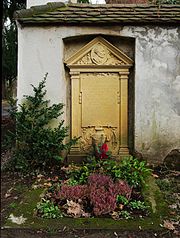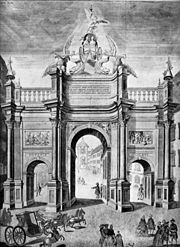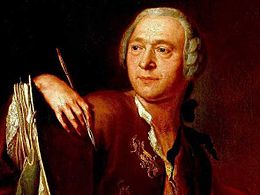Johann Christian Wentzinger
Johann Christian Wentzinger (originally Christian Wen (t) zinger ; * December 10, 1710 in Ehrenstetten im Breisgau; † July 1, 1797 in Freiburg im Breisgau ) was a southern German sculptor , painter and architect of the Rococo , who mainly worked in Breisgau. Wentzinger had had the second first name "Johann", which was not documented in the baptismal entry, since the 1730s. He used the spelling “Wentzinger” in all of his own handwritten documents, the variant “Wenzinger” also applied to contemporaries. He is one of the most versatile Rococo artists in southern Germany.
Life




Study trips took him after his training (probably in Freiburg) and the journeyman time in Strasbourg in 1731 with François Ludwig Foisset (1687–1745) to Rome and 1737 to Paris . After further training at the local academies , Wentzinger saw himself as an academic artist above the craft and was therefore not subject to the guild obligation . From 1745 he worked from Freiburg in the entire Breisgau and the neighboring regions. His residential and studio building "Zum Schönen Eck" ( Wentzingerhaus ), which was built after 1761 on Freiburg Munsterplatz and already furnished with early classical details, has housed the Freiburg Museum of City History since 1994 .
Wentzinger bequeathed his considerable fortune to the Freiburg poor hospital. The city honored Wentzinger's artistic and social work with his appointment as an honorary citizen and honorary city councilor while he was still alive. The hand of Katharina Egg, the mayor's daughter, was denied to him.
Wentzinger was buried in the old cemetery .
plant
Wentzinger worked in particular as a sculptor and painter, and according to his own statement also as an architect. In any case, his contemporaries saw him as a “building wise” artist whose opinion was in demand for urban and private buildings.
Wentzinger's contributions to the design of the collegiate church of St. Gallen , whose furnishings he directed from 1757–1760, are to be considered as main works : larger-than-life statues on the exterior, ceiling and dome frescoes in the church interior , stucco ornamentation , allegorical and scenic reliefs . He had already carried out an extensive range of decorations in Ebnet Castle near Freiburg in 1748 . There he also created garden sculptures (Four Seasons - originals since 1992 in the Wentzingerhaus) and stucco. Numerous works are kept in the Augustinermuseum in Freiburg. The Mount of Olives from Staufen is now in the Liebieghaus in Frankfurt am Main .
In Freiburg Cathedral to his tomb of General and finds Breisach fortress commander Franz Christoph von Rodt (1671-1743) and the baptismal font, which was designed by him in 1768 and modeled. However, this was carried out by Joseph Hörr and Anton Xaver Hauser .
He also created a triumphal arch for Marie Antoinette when she was traveling through Freiburg on her bridal voyage in the spring of 1770 .
reception
In Freiburg, next to the Wentzingerhaus, a street, two schools ( Wentzinger-Gymnasium and Wentzinger-Realschule) and an office complex (Wentzinger-Hof) were named after the artist.
For the 300th birthday of the artist, the Augustinermuseum organized an exhibition from November 27, 2010 to March 6, 2011.
literature
- Alois Siegel : Wenzinger, Christian . In: Hans Vollmer (Hrsg.): General lexicon of fine artists from antiquity to the present . Founded by Ulrich Thieme and Felix Becker . tape 35 : Libra-Wilhelmson . EA Seemann, Leipzig 1942, p. 385-386 .
- Ingeborg Krummer-Schroth : Johann Christian Wentzinger. Sculptor, painter, architect, 1710–1797. Schillinger, Freiburg 1987, ISBN 3-89155-058-8 (with catalog of works and bibliography).
- Michel Reistle: Joseph Wannenmacher. A Swabian church painter of the 18th century and his relationship with the sculptor Wenzinger. EOS, St. Ottilien 1990, ISBN 3-88096-697-4 .
- Johann Christian Wentzinger. The four Seasons". Kulturstiftung der Länder, Berlin 1993.
- Saskia Durian-Ress : Christian Wenzinger. The sculptures. Hirmer, Munich 2010, ISBN 978-3-7774-2601-3 (with catalog of works and bibliography).
- Freiburg baroque. Johann Christian Wentzinger and his time (1710–1797). An exhibition by the Freiburg Municipal Museums, Augustinermuseum. Deutscher Kunstverlag, Berlin, Munich 2010, ISBN 978-3-422-07039-4 .
Web links
- Literature by and about Johann Christian Wentzinger in the catalog of the German National Library
Individual evidence
- ^ A b c Frank Zimmermann: Exhibition Preview: Exhibition: Johann Christian Wentzinger - Master of the Baroque . In: Badische Zeitung. March 7, 2010, accessed December 30, 2010.
- ^ Rudolf Reinhardt : Maximilian Christoph v. Rodt. In: New German Biography (NDB). Volume 16, Duncker & Humblot, Berlin 1990, ISBN 3-428-00197-4 , p. 506 f. ( Digitized version ).
- ↑ Karl Schuster : On the building history of the Freiburg Minster in the 18th century ( Memento of the original from December 12, 2013 in the Internet Archive ) Info: The archive link was inserted automatically and has not yet been checked. Please check the original and archive link according to the instructions and then remove this notice. . In: Münsterbau-Verein (Hrsg.): Freiburger Münsterblätter: Semi-annual publication for the history and art of the Freiburg Minster 5. Freiburg im Breisgau 1909, p. 7 f.
- ^ Frank Zimmermann: Exhibition: Johann Christian Wentzinger - Meister des Barock , Badische Zeitung of March 17, 2010, accessed on December 19, 2010.
- ^ Heinrich Schreiber : History of the City and University of Freiburg im Breisgau , Volume 1, FX Wangler, Freiburg im Breisgau 1868, p. 364 f, full text in the Google book search.
| personal data | |
|---|---|
| SURNAME | Wentzinger, Johann Christian |
| ALTERNATIVE NAMES | Wentzinger, Johan Christian; Wenzinger, Christian; Wenzinger, Christian |
| BRIEF DESCRIPTION | German sculptor, painter and architect of the Rococo |
| DATE OF BIRTH | December 10, 1710 |
| PLACE OF BIRTH | Ehrenstetten |
| DATE OF DEATH | July 1, 1797 |
| Place of death | Freiburg in Breisgau |
